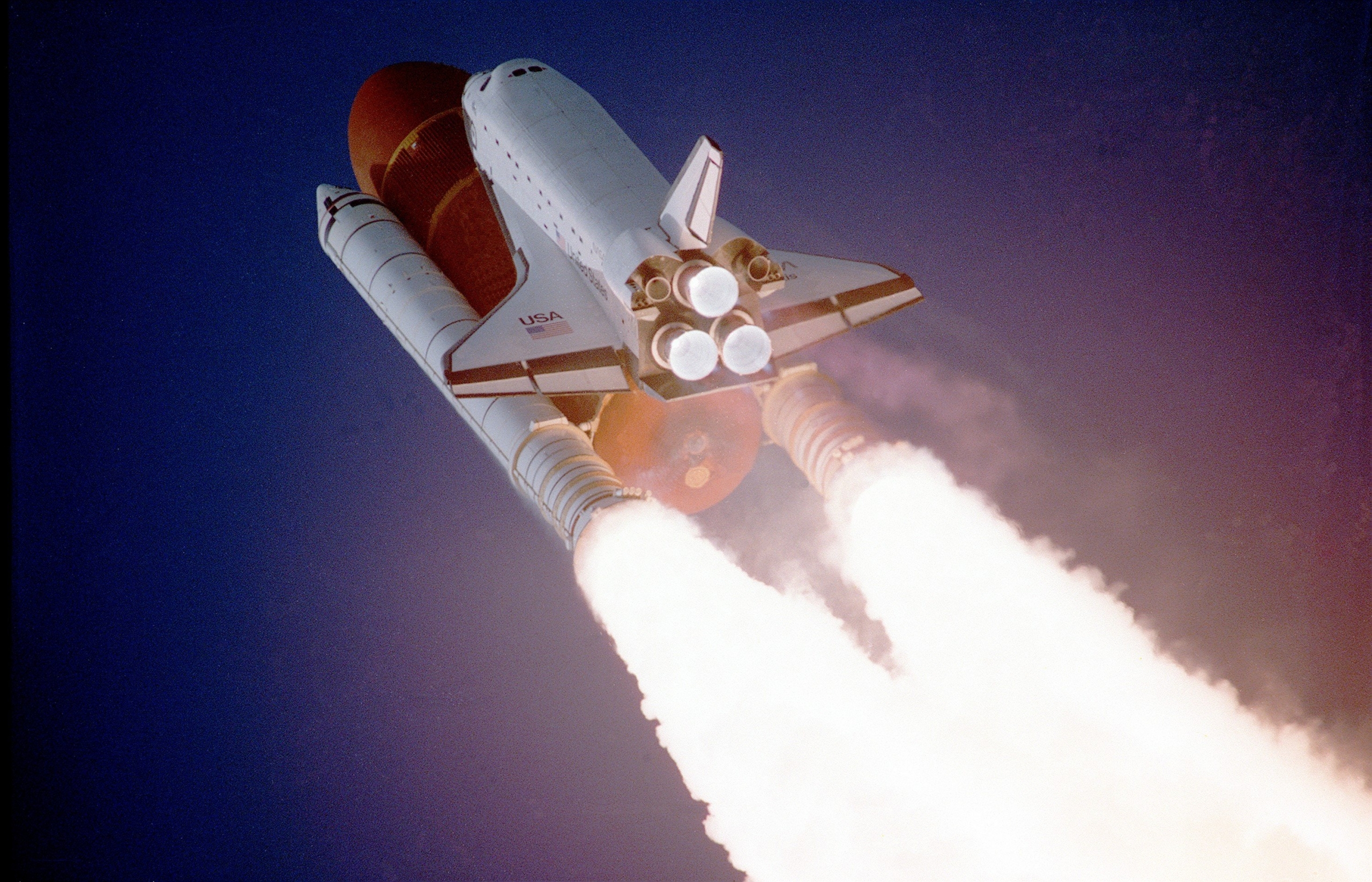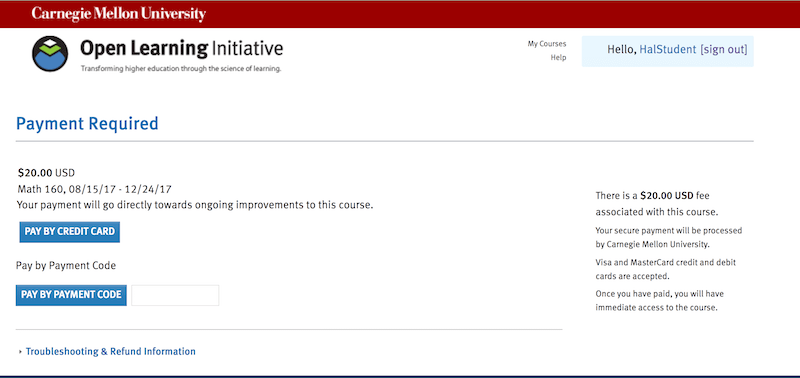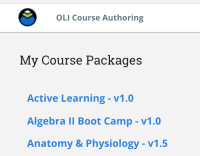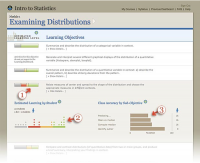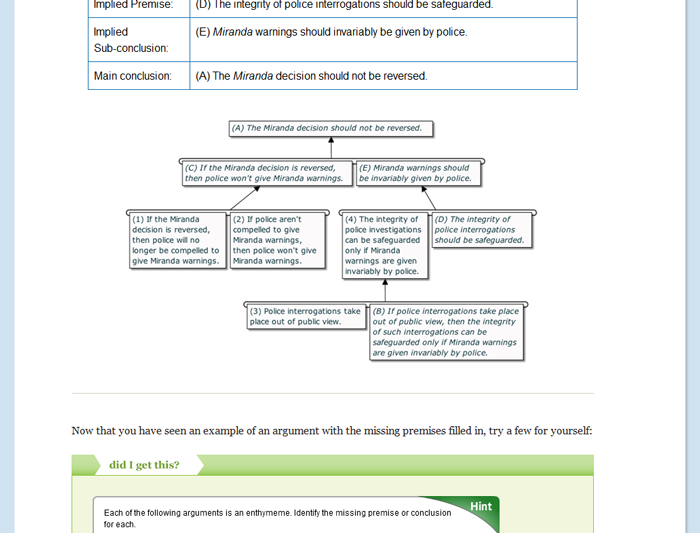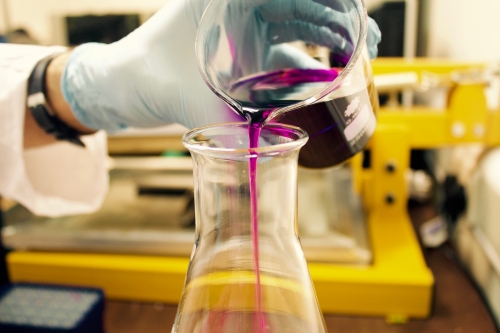College Physics 1 is a one-semester course covering classical mechanics, work, energy, sound, fluid statics and dynamics, and thermodynamics.
College Physics 1
$25
- Description
- What students will learn
- Learning objectives
- Course assessments, activities, and outline
- Other course details
- System requirements
- Included instructor tools
Description
The College Physics 1 course is an algebra-based Physics course covering classical mechanics, work, energy, sound, fluid Statics and dynamics, and thermodynamics. The course covers all the topics included in the first semester of College Physics and includes formative assessments with scaffolding, and summative assessments at the end of each module.
The course is grounded in real-world examples, interactives, lecture videos, simulations, and scaffolded practice problems all designed in a logical flow. The course also has an introductory module in Mathematics containing essential Trigonometry and Algebra review needed for problem solving in the course.
What students will learn
Topics Covered:
- Course Introduction
- Mathematics Review
- Introduction to Physics
- Motion in One Dimension (Kinematics)
- Vectors
- Motion in Two Dimensions (Projectile Motion, Relative Velocity, etc)
- Newton’s Laws of Motion
- Applications of Newton’s Laws of Motion
- Uniform Circular Motion
- Energy and Newton’s Law of Gravitation
- Work and Power
- Momentum and Collisions
- Rotational Dynamics
- Fluids
- Oscillations
- Waves
- Thermodynamics
Learning objectives
Module 1: Course Introduction
• Describe how the “Big Ideas” in College Physics 1 develop a context that facilitates a deep understanding of key concepts, connections, and interdependencies.
• Explain how the knowledge of Physics fits into the context of our everyday lives.
Module 2: Mathematics Review
• Use methods of Algebra to solve for unknown quantities.
• Use relationships in trigonometry with algebra to find an unknown quantity
Module 3: Introduction to Physics
• Distinguish between a principle, law, model, and theory.
• Explain SI units, and Derived units and be able to write SI unit’s most common prefixes in scientific notation.
• Determine the appropriate number of significant figures in both addition and subtraction, as well as multiplication and division calculations.
• Calculate the percent uncertainty of a measurement.
• Estimate calculations with appropriate rounding, assumptions, and approximations so that results are accurate within an order of magnitude of the exact value.
Module 4: Motion in One-Dimension
• Calculate displacement and distance given the initial position, final position, and the path between the two.
• Define and distinguish between scalar and vector quantities.
• Assign a coordinate system for a scenario involving one-dimensional motion.
• Calculate velocity and speed given initial position, initial time, final position, and final time.
• Interpret a graph of position, velocity, and acceleration graphs.
• Define and distinguish between instantaneous acceleration, average acceleration, and deceleration.
• Calculate acceleration given initial time, initial velocity, final time, and final velocity.
• Calculate the displacement of an object that is not accelerating, given initial position and velocity.
• Calculate the final velocity of an accelerating object, given initial velocity, acceleration, and time.
• Calculate the displacement and final position of an accelerating object, given the initial position, initial velocity, time, and acceleration.
• Describe the effects of gravity on objects in motion.
• Describe the motion of objects that are in free fall.
• Calculate the position and velocity of objects in free fall.
Module 5: Vectors
• Identify the independence of horizontal and vertical vectors in two-dimensional motion.
• Calculate the displacement between the start and end points of a journey.
• Apply the rules of vector addition, subtraction, and multiplication.
• Apply graphical methods of vector addition and subtraction to determine the displacement of moving objects.
• Explain the rules of vector addition and subtraction using analytical methods.
• Apply analytical methods to determine vertical and horizontal component vectors.
• Apply analytical methods to determine the magnitude and direction of a resultant vector.
Module 6: Motion in Two-Dimensions
• Calculate the properties of a projectile, such as acceleration due to gravity, range, maximum height, and trajectory.
• Determine the location and velocity of a projectile at different points in its trajectory.
• Apply the principle of independence of motion to solve projectile motion problems.
• Apply principles of vector addition to determine relative velocity
Module 7: Newton’s Laws of Motion
• Summarize the definition of force.
• Define mass and inertia.
• Analyze situations where a particle remains at rest or has constant velocity under the influence of multiple forces.
• Define net force, external force, and system.
• Apply Newton’s second law to determine the weight of an object.
• Apply Newton’s third law to define systems and solve problems of motion.
• Identify pairs of action and reaction forces and objects on which they act.
Module 8: Applications of Newton’s Laws of Motion
• Write the expressions and calculate normal forces for an object that is stationary or moving on a plane surface or on an incline
• Use trigonometric identities to resolve weight into components.
• Calculate tension forces for an object
• Interpret and apply a problem-solving procedure to solve problems using Newton’s laws of motion.
• Calculate the magnitude of static and kinetic friction.
• Explain Hooke’s law using a graphical representation between deformation and applied force.
• Discuss the three types of deformations such as changes in length, sideways shear, and changes in volume.
• Determine the change in length given mass, length, and radius.
• Describe with examples the young’s modulus, shear modulus, and bulk modulus.
Module 9: Uniform Circular Motion
• Calculate arc length, rotation angle, and radius of curvature for a rotating body.
• Calculate the angular velocity of a body.
• Calculate the centripetal acceleration.
• Explain the centrifuge.
• Calculate the Centripetal Force on a Rotating Body
• Calculate the ideal speed and angle of a car on a turn
Module 10: Energy and Newton’s Laws of Gravitation
• Calculate Mechanical Work
• Explain how relative directions of force and displacement determine whether the work done is positive, negative, or zero.
• Explain work as a transfer of energy and net work as the work done by the net force.
• Apply the Work-Energy Theorem
• Explain gravitational potential energy in terms of work done against gravity.
• Define conservative force, potential energy, and mechanical energy.
• Calculate the potential energy of spring in terms of its compression when Hooke’s law applies.
• Use the work-energy theorem to show how having only conservative forces implies the conservation of mechanical energy.
• Apply Newton’s Law of Gravitation
• Describe the gravitational effect of the Moon on Earth.
• Discuss weightlessness in space.
• Examine the Cavendish experiment
Module 11: Energy and Power
• Define nonconservative forces and explain how they affect mechanical energy.
• Apply the principle of conservation of energy by treating the conservative forces in terms of their potential energies and any nonconservative forces in terms of the work they do.
• Apply the law of conservation of energy.
• Describe what happens to the energy in the system when the reference height changes.
• Calculate power by calculating changes in energy over time.
Module 12: Momentum and Collisions
• Calculate momentum given mass and velocity.
• Describe the effects of impulses in everyday life.
• Calculate average force and impulse given mass, velocity, and time.
• Determine the average effective force using a graphical representation.
• Explain the conservation of momentum with examples.
• Determine the final velocities in an elastic collision given masses and initial velocities.
• Determine recoil velocity and loss in kinetic energy given mass and initial velocity.
• Calculate the angular acceleration of an object.
• Describe the link between linear and angular acceleration.
Module 13: Rotational Dynamics
• Describe the analogy between force and torque, mass and moment of inertia, and linear acceleration and angular acceleration.
• Apply the first condition of equilibrium.
• State the second condition that is necessary to achieve equilibrium.
• Calculate Torque
• State the types of equilibrium.
• Apply various problem-solving strategies in Statics.
• Calculate rotational kinetic energy.
• Apply the Law of Conservation of Energy for rotational motion.
Module 14: Fluids
• Explain the relationship between mass, volume, and density for solids and liquids, and calculate the unknown quantity when 2 of these quantities are given.
• Apply the relationship between pressure, force, and area for solids and liquids to calculate the unknown quantity when 2 of these quantities are given.
• Apply the relationship between pressure and depth in a fluid to analyze situations that involve measuring pressure at a certain depth in a fluid.
• Explain relationships between forces in a hydraulic system.
• Apply Pascal’s principle to calculate the amount of force required to lift heavy weights in machines such as a hydraulic jack
• Calculate gauge pressure and absolute pressure.
• Explain the working of aneroid and open-tube barometers or manometers.
• Explain the relationship between density and Archimedes’ principle
• Explain why objects float or sink.
• Calculate flow rate.
• Explain the consequences of the equation of continuity.
• Calculate with Bernoulli’s principle.
• Calculate using Torricelli’s theorem.
• Calculate power in fluid flow.
• Calculate flow and resistance with Poiseuille’s law.
• Explain how pressure drops due to resistance.
Module 15: Oscillations
• Explain Newton’s third law of motion with respect to stress and deformation.
• Describe the restoration of force and displacement.
• Calculate the energy in Hooke’s Law of deformation and the stored energy in a spring.
• State the relationship between parameters describing oscillations such as frequency and time period.
• Analyze problems in which mass hangs from a spring and oscillates vertically
• Analyze the motion of a simple pendulum and state the relationship between the length of the pendulum, acceleration due to gravity, and time period/frequency of oscillations.
• Apply the principle of conservation of energy to an ideal simple harmonic oscillator such as a spring-mass system (to derive max speed, max potential energy, and kinetic energy)
• Determine the points and times of maximum potential energy and maximum kinetic energy for a simple harmonic oscillator
• Compare simple harmonic motion with uniform circular motion
Module 16: Waves
• Calculate the wavelength, frequency, velocity, and time period of a wave
• Differentiate between transverse and longitudinal waves
• Calculate the beat frequency of standing waves.
• Apply the principle of superposition traveling waves moving in opposite directions, and describe how a standing wave may be formed by superposition.
• Compare and contrast the effects of constructive and destructive interference
• Define sound and hearing. Determine how sound is created.
• Define pitch.
• Describe the relationship between the speed of sound, its frequency, and its wavelength.
• Describe the effects on the speed of sound as it travels through various media.
• Describe the effects of temperature on the speed of sound.
• Define intensity, sound intensity, and sound pressure level.
• Calculate sound intensity given the power and area or given the pressure variation and the density of material through which sound travels.
• Analyze situations where there is a relative motion between wave source and observer to calculate the apparent frequency emitted by the source as recorded by the observer
• Describe the phenomenon of resonance in waves citing a few real life examples.
• Describe how sound interference occurring inside open and closed tubes changes the characteristics of the sound, and how this applies to sounds produced by musical instruments.
Module 17: Thermodynamics
• Convert temperatures between the Celsius, Fahrenheit, and Kelvin scales.
• State the zeroth law of thermodynamics.
• Calculate the thermal stress on an object given its original volume, temperature change, volume change, and bulk modulus.
• State the ideal gas law in terms of molecules and in terms of moles.
• Use the ideal gas law to calculate pressure change, temperature change, volume change, or the number of molecules or moles in a given volume.
• Use Avogadro’s number to convert between the number of molecules and the number of moles.
• Express the ideal gas law in terms of molecular mass and velocity.
• Describe the relationship between the temperature of a gas and the kinetic energy of atoms and molecules.
• Describe the distribution of speeds of molecules in a gas.
• Calculate the final temperature after heat transfer between two objects.
• Explain the different methods of heat transfer.
• Explain the first law of thermodynamics and identify instances of the law working in everyday situations.
• Calculate changes in the internal energy of a system, after accounting for heat transfer and work done.
• Describe the processes of a simple heat engine.
• Explain the differences among the simple thermodynamic processes—isobaric, isochoric, isothermal, and adiabatic.
• Calculate the total work done in a cyclical thermodynamic process.
• State the expressions of the second law of thermodynamics.
• Calculate the efficiency and carbon dioxide emission of a coal-fired electricity plant, using second law characteristics.
• Describe and define the Otto cycle.
• Calculate the maximum theoretical efficiency of a nuclear reactor
Course assessments, activities, and outline
The course consists of:
- practice activities
- Physics text from Open Stax
- videos
- quizzes
- reflection opportunities
Other course details
System requirements
OLI system requirements, regardless of course:
- internet access
- an operating system that supports the latest browser update
- the latest browser update (Chrome recommended; Firefox, Safari supported; Edge and Internet Explorer are supported but not recommended)
- pop-ups enabled
- cookies enabled
Some courses include exercises with exceptions to these requirements, such as technology that cannot be used on mobile devices.
This course’s system requirements:
- N/A
Included instructor tools
Instructors who teach with OLI courses benefit from a suite of free tools, technologies, and pedagogical approaches. Together they equip teachers with insights into real-time student learning states; they provide more effective instruction in less time; and they’ve been proven to boost student success.

